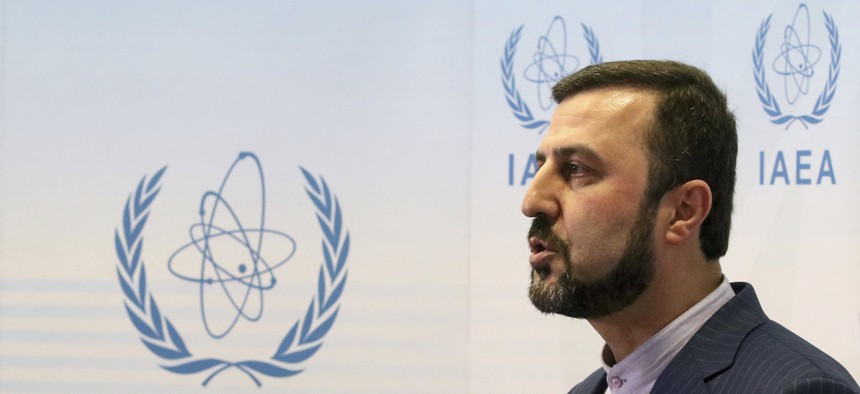
Iran's Ambassador to the International Atomic Energy Agency, IAEA, Gharib Abadi speaks to the media after the IAEA board of governors meeting at the International Center in Vienna, Austria, Wednesday, July 10, 2019. AP Photo/Ronald Zak
There’s a Deal to Be Had Between the US and Iran
For now, though, both sides seem to prefer escalating pressure.
Iran is now incrementally walking away from the limits imposed on it in the nuclear deal—the Joint Comprehensive Plan of Action, or JCPOA—exceeding the 300 kilograms of low enriched uranium it can have on hand and now enriching above the 3.67 percent allowed under the terms of the understanding. Don’t be surprised if it either starts to install its advanced centrifuges or begins to operate more than the 5,061 older centrifuges it is permitted for enrichment. Iran is not racing to produce weapons-grade material, but make no mistake, it is shrinking the time it will need to have a breakout capability.
The Trump administration’s decision to end the waivers it had given eight countries to continue to buy Iranian oil, in late April, put the Iranians in a real bind. The country’s oil exports plummeted from roughly a million barrels a day to roughly 300,000. The resulting loss of revenue added dramatically to the already significant economic pressures caused by the American reimposition of sanctions—and the reality that multinational corporations felt the need to respect the sanctions lest they lose the ability to do business in the United States or get financing from American banks.
Iran is now answering the Trump administration’s “maximum pressure” policy by placing maximum pressure on Donald Trump. Reducing its breakout time—and emphasizing the Trump administration’s inability to restrain it—is one way that Iran is raising the pressure. Tehran is also ramping up its threatening actions in the region. Saudi civilian airfields, oil pipelines, and petroleum pumping stations are being targeted every few days by the Houthis from Yemen with Iranian-provided drones and missiles; six ships on two different occasions have been sabotaged with limpet mines south of the Strait of Hormuz; bases in Iraq where American forces are located have been hit by rockets fired by Shia militias armed and trained by the Iranians; Israeli security officials tell me that Islamic jihad—likewise supported by Iran—is trying hard to provoke a conflict with Israel in Gaza; and, of course, an American drone was shot down by the Iranians.
A week before the White House decision on the waivers, the State Department was informing countries that they would be continued. The State Department favored keeping the waivers because it understood it was getting the best of both worlds: Iran was under pressure, with its economy reeling, and yet the Iranians were abiding by their obligations in the JCPOA—something that relieved the administration of figuring out what to do if the Iranians actually walked away and began to reduce their breakout time.
Related: Trump’s ‘Maximum Pressure’ Won’t Make Iran Yield
Related: Trump’s Iran Policy Is Counterproductive
Related: Is There Still a Deal to Be Done With Iran?
Rescinding the waivers persuaded the Iranians that they must show Trump, the Europeans, and our friends in the region that they, too, could impose a price and were not simply going to acquiesce to U.S. pressure. Ali Khamenei, Iran’s supreme leader, in a speech on May 29, declared that the U.S. was trying to pressure the Islamic Republic to return to the negotiating table in a weakened condition. He said that would not happen; instead, he said, Iran would apply its “leverage”—and it is clearly doing so.
Each side seems to be operating on the assumption that mounting pressure will force the other side to blink. The danger, of course, is a miscalculation that produces a conflict even if neither side wants it. Assuming conflict can be avoided, Iran’s president, foreign minister, and deputy foreign minister are saying they will reverse their breaches of the JCPOA if the U.S. comes back to the deal or the Europeans deliver economic benefits. Neither prospect seems likely—and yet, Iranian President Hassan Rouhani has agreed to consider French President Emmanuel Macron’s call for negotiations.
Can the Europeans successfully mediate between the Iranians and Trump? They might start by brokering an understanding in which the Iranians come back into compliance and help de-escalate in the region in return for the Trump administration reconstituting the waivers rescinded in April.
The Trump administration has no real answer to Iranian maximum pressure and clearly does not want conflict. That might be enough to persuade Trump to accept such an understanding. In Japan, Trump conveyed his basic instinct on Iran, saying he was not interested in regime change, just “no nukes.” Trump’s only real criterion is doing better than Barack Obama, and that probably means extending the sunset provision on the limits on Iranian enrichment for another 10 to 15 years, out to 2040 or 2045. But the Iranians won’t make such a concession for nothing; they would likely demand the end not just of the sanctions imposed to constrict Iran’s nuclear activity, but of the broader array of sanctions.
American sanctions imposed on Iran as a result of its support for terror and its violations of human rights cannot and should not be lifted, given Iran’s ongoing acts and policies. Moreover, JCPOA 2.0 is likely to be no more sustainable than its first version if Iran does not change its behavior in the region. No grand bargain, magically overcoming all U.S.-Iranian differences, lies within the realm of possibility.
There is, however, a realistic and achievable compromise to be had. Iran could agree to an extension of the sunset provisions for 10 to 15 years, as well as to limit rockets, missiles, and military infrastructure in Syria and Lebanon, reducing the prospect of a wider regional war between Israel and Iran. In return, the U.S. would lift the nuclear sanctions and create a special-purpose vehicle, which would allow American and international firms to do business in Iran so long as they complied with a strict set of rules. It wouldn’t offer everything either side wants, but it would produce more for each side than the current impasse.
For now, however, Iran appears to prefer to escalate the pressure it is applying to the U.S. Unless the supreme leader comes to fear that the U.S. will act militarily or that economic pressures are placing domestic peace at risk, he is unlikely to accept a deal anytime soon. And that, ironically, means the risk of a conflict that neither side actually wants remains high—high enough to motivate the Europeans to do all they can to persuade each side to de-escalate and broker a new understanding.
NEXT STORY: Russia, China Offer Challenges in the Arctic





